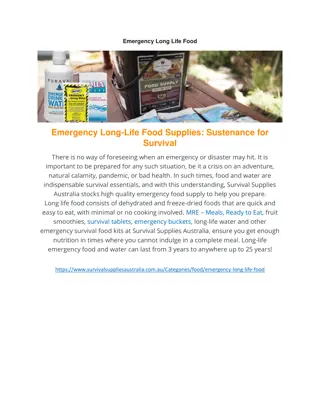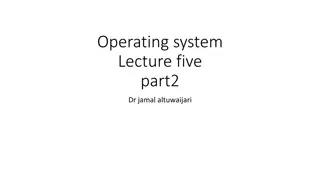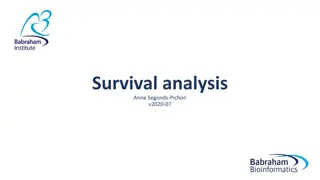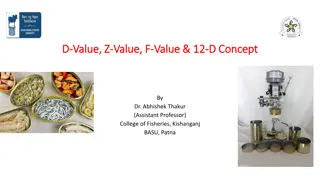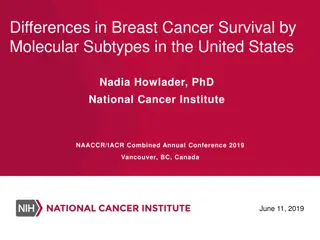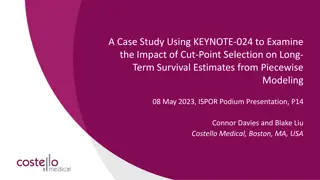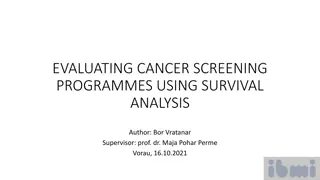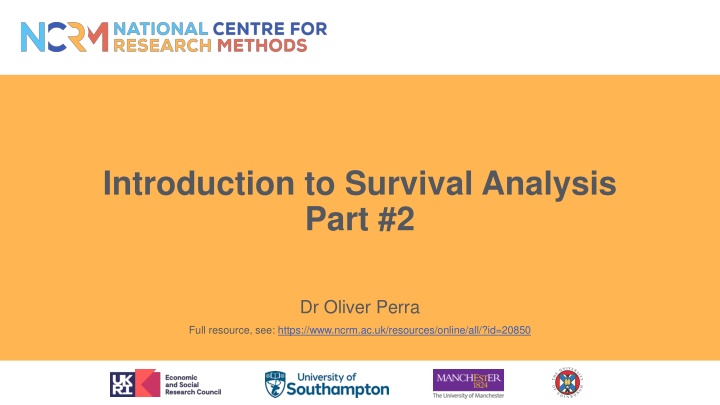
Survival Analysis: Censoring, Life Tables, and Hazard Functions
Dive into survival analysis with Dr. Oliver Perra as he explains the concepts of censoring, life tables, and hazard functions. Learn about challenges, data interpretation, and prediction modeling using real-world datasets.
Download Presentation

Please find below an Image/Link to download the presentation.
The content on the website is provided AS IS for your information and personal use only. It may not be sold, licensed, or shared on other websites without obtaining consent from the author. If you encounter any issues during the download, it is possible that the publisher has removed the file from their server.
You are allowed to download the files provided on this website for personal or commercial use, subject to the condition that they are used lawfully. All files are the property of their respective owners.
The content on the website is provided AS IS for your information and personal use only. It may not be sold, licensed, or shared on other websites without obtaining consent from the author.
E N D
Presentation Transcript
Introduction to Survival Analysis Part #2 Dr Oliver Perra Full resource, see: https://www.ncrm.ac.uk/resources/online/all/?id=20850
So far Survival Analysis: statistical method to answer questions concerning: Whether and When an event takes place Prerequisites: #1 Define event occurrence: transitions between states #2 Identify beginning of time : starting point of study should not be related to the target event occurrence #3 Specify time metric: smallest possible unit relevant to the event of interest
Outline Censoring and its challenges Life Tables for Discrete Time Event Occurrence Hazard Function Survivor Function
A key challengeCensoring Some participants never experience the event (#4) during the study Some leave the study before we can record the event (#5)
A key challengeCensoring Non-informative: Independent of event occurrence. E.g.: by design end of the study Informative: Participants with censored data are likely to have experienced the event
Dataset Capaldi et al. (1996): Predicting the Timing of First Sexual Intercourse for At-Risk Adolescent Males. NOTE: modified dataset N = 180 Beginning of time: Grade year 7; Time metric: Grade years 7 to 12 (discrete); Target Event: YearlySelf- reported initiation of intercourse; Covariates: Parental Transitions (pt); Parental Antisocial Scores (pas)
Dataset Capaldi et al. (1996): Predicting the Timing of First Sexual Intercourse for At-Risk Adolescent Males. NOTE: I have modified the dataset Beginning of time: Grade year 7; Time metric: Grade years 7 to 12; Target Event: YearlySelf- reported initiation of intercourse; Covariates: Parental Transitions (pt); Parental Antisocial Scores (pas)
Dataset Capaldi et al. (1996): Predicting the Timing of First Sexual Intercourse for At-Risk Adolescent Males. NOTE: I have modified the dataset Beginning of time: Grade year 7; Time metric: Grade years 7 to 12; Target Event: YearlySelf- reported initiation of intercourse; Covariates: Parental Transitions (pt); Parental Antisocial Scores (pas)
The Life Table Rows: time intervals including initial time and excluding concluding time. n.risk: Risk Set, number at risk in each interval Not censored, still in the study & Not yet experienced the target event i.e., are at risk of experiencing the event
Discrete Time Hazard Function: Conditional probability that participant will experience the event in the given interval, provided the participant did not experience it in any previous time period. (???) = Pr ??= ? ?? ?] Where: ? ??????????? ?? ?????; ? ???? ?????? ?? ?????; ?? ???? ?????? ? ? ??? ?????????? ? ??????????? ?????? ?????;
Discrete-time Hazard Function: Conditional probability that individual will experience the event in the given interval, provided the participant did not experience it in any previous time period. For j intervals: ? ?????? ? ?? ????? = 18 158= .114
Discrete-time Hazard Function: For j intervals: ? ?????? ? ?? ?????
Survivor Function Probability of surviving past a time interval j for a randomly selected individual i. For j intervals: ? ? ? ??? ??? ??? ??????????? ????? ??? ?? ???????? ? ? = 158 180= .878
Survivor Function Probability of surviving past a time interval j for a randomly selected individual i. For j intervals: ? ? ? ??? ??? ??? ??????????? ????? ??? ?? ???????? ? ? = ??? 180= ???
Survivor Function Probability of surviving past a time interval j for a randomly selected individual i. 1 .083 = 0.917 For j intervals: ? ? ? ??? ??? ??? ??????????? ????? ??? ?? ???????? ? ?
Survivor Function Probability of surviving past a time interval j for a randomly selected individual i. (1- .042) survive in the year. But only .917 from original sample are still at risk. Therefore: (1- .042) * .917 = .878 ?(??) = ?(?? 1) [1 (??)] Where: ? ??????????? ?? ?????; ? ???? ?????? ?? ?????; (??) ????????? ????? ?? ???? ?????? ? The same logic applies to periods where there is censoring
Median Lifetime Survivor Function: Probability of surviving past a time interval j for a randomly selected individual i. Median Lifetime: Time point where the value of the estimated survivor function is .50
Summary Censoring: analyses assume non-informative mechanisms Life Tables summarise event occurrence over time Hazard function: conditional probability of individual experiencing the event in the interval, given they did not experience it before Survivor function: probability of surviving past a time interval for a randomly selected individual

